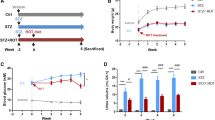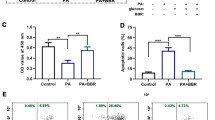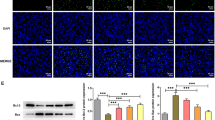Abstract
Tumor suppressor p53 is a transcriptional factor that determines cell fate in response to multiple stressors, such as oxidative stress and endoplasmic reticulum stress, in the majority of cells. However, its role in pancreatic beta cells is not well documented. Our previous research has revealed that glycation-serum (GS) induced pancreatic beta-cell demise through the AGEs-RAGE pathway. In the present study, we investigated the role of p53 in GS-related beta-cell demise. Using pancreatic islets beta-cell line INS-1 cells, we found that with GS treatment, the transcriptional activity of p53 was significantly evoked due to the increased amount of nuclear p53 protein. Resveratrol (RSV) was capable of further enhancing this transcriptional ability and consequently increased the population of dead beta cells under GS exposure. In contrast, inhibiting this transcriptional activity via p53 interference greatly protected beta cells from the damage provoked by GS, as well as damage strengthened by RSV. However, the pharmacological activation of PPARγ with troglitazone (TRO) only suppressed GS-induced, not RSV-induced, p53 activity. Moreover, the activation of PPARγ greatly preserved beta cells from GS-induced death. This protective effect recurred due to improved mitochondrial function with Bcl2 overexpression. Further, p53 activation could induce cellular apoptosis in primary rat islets. Our findings explore the broader role of p53 in regulating pancreatic beta-cell demise in the presence of GS and may provide a therapeutic target for the treatment and prevention of diabetes.







Similar content being viewed by others
References
Z. Fu, E.R. Gilbert, D. Liu, Regulation of insulin synthesis and secretion and pancreatic beta-cell dysfunction in diabetes. Curr. Diabetes Rev. 9, 25–53 (2013)
S. Cernea, M. Dobreanu, Diabetes and beta cell function: from mechanisms to evaluation and clinical implications. Biochemia Medica 23, 266–280 (2013)
Y. Hirasawa, Y. Matsui, S. Ohtsu, K. Yamane, T. Toyoshi, K. Kyuki, T. Sakai, Y. Feng, T. Nagamatsu, Involvement of hyperglycemia in deposition of aggregated protein in glomeruli of diabetic mice. Eur. J. Pharmacol. 601, 129–135 (2008)
K. Nowotny, T. Jung, A. Hohn, D. Weber, T. Grune, Advanced glycation end products and oxidative stress in type 2 diabetes mellitus. Biomolecules 5, 194–222 (2015)
J. O’Brien, P.A. Morrissey, Nutritional and toxicological aspects of the Maillard browning reaction in foods. Crit. Rev. Food Sci. Nutr. 28, 211–248 (1989)
R. Ramasamy, S.J. Vannucci, S.S. Yan, K. Herold, S.F. Yan, A.M. Schmidt, Advanced glycation end products and RAGE: a common thread in aging, diabetes, neurodegeneration, and inflammation. Glycobiology 15, 16R–28R (2005)
H. Vlassara, G.E. Striker, Advanced glycation end products in diabetes and diabetic complications. Endocrinol. Metab. Clin. N. Am. 42, 697–719 (2013)
R. Pokupec, M. Kalauz, N. Turk, Z. Turk, Advanced glycation end products in human diabetic and non-diabetic cataractous lenses. Graefes. Arch. Clin. Exp. Ophthalmol. 241, 378–384 (2003)
O. Sandu, K. Song, W. Cai, F. Zheng, J. Uribarri, H. Vlassara, Insulin resistance and type 2 diabetes in high-fat-fed mice are linked to high glycotoxin intake. Diabetes 54, 2314–2319 (2005)
E.J. Gallagher, D. LeRoith, E. Karnieli, The metabolic syndrome-from insulin resistance to obesity and diabetes. Endocrinol. Metab. Clin. N. Am. 37, 559–579 (2008)
W. Cai, M. Ramdas, L. Zhu, X. Chen, G.E. Striker, H. Vlassara, Oral advanced glycation end products (AGEs) promote insulin resistance and diabetes by depleting the antioxidant defenses AGE receptor-1 and sirtuin 1. Proc. Natl. Acad. Sci. USA 109, 15888–15893 (2012)
G. Luciano Viviani, A. Puddu, G. Sacchi, A. Garuti, D. Storace, A. Durante, F. Monacelli, P. Odetti, Glycated fetal calf serum affects the viability of an insulin-secreting cell line in vitro. Metabolism. 57, 163–169 (2008)
X. Kong, G.D. Wang, M.Z. Ma, R.Y. Deng, L.Q. Guo, J.X. Zhang, J.R. Yang, Q. Su, Sesamin ameliorates advanced glycation end products-induced pancreatic beta-cell dysfunction and apoptosis. Nutrients 7, 4689–4704 (2015)
J. Uribarri, W. Cai, M. Ramdas, S. Goodman, R. Pyzik, X. Chen, L. Zhu, G.E. Striker, H. Vlassara, Restriction of advanced glycation end products improves insulin resistance in human type 2 diabetes: potential role of AGER1 and SIRT1. Diabetes Care 34, 1610–1616 (2011)
H. Vlassara, G.E. Striker, AGE restriction in diabetes mellitus: a paradigm shift. Nat. Rev. Endocrinol. 7, 526–539 (2011)
C. Luevano-Contreras, M.E. Garay-Sevilla, K. Wrobel, J.M. Malacara, K. Wrobel, Dietary advanced glycation end products restriction diminishes inflammation markers and oxidative stress in patients with type 2 diabetes mellitus. J. Clin. Biochem. Nutr. 52, 22–26 (2013)
A. Puddu, R. Sanguineti, A. Durante, A. Nencioni, F. Mach, F. Montecucco, G.L. Viviani, Glucagon-like peptide-1 triggers protective pathways in pancreatic beta-cells exposed to glycated serum. Mediat. Inflamm. 2013, 317120 (2013)
T. Shu, Y. Zhu, H. Wang, Y. Lin, Z. Ma, X. Han, AGEs decrease insulin synthesis in pancreatic beta-cell by repressing Pdx-1 protein expression at the post-translational level. PLoS ONE 6, e18782 (2011)
Y. Zhu, T. Shu, Y. Lin, H. Wang, J. Yang, Y. Shi, X. Han, Inhibition of the receptor for advanced glycation end products (RAGE) protects pancreatic beta-cells. Biochem. Biophys. Res. Commun. 404, 159–165 (2011)
L. Jiang, J.H. Hickman, S.J. Wang, W. Gu, Dynamic roles of p53-mediated metabolic activities in ROS-induced stress responses. Cell Cycle 14, 2881–2885 (2015)
N. Sen, Y.K. Satija, S. Das, PGC-1alpha, a key modulator of p53, promotes cell survival upon metabolic stress. Mol. Cell 44, 621–634 (2011)
S.E. Thomas, E. Malzer, A. Ordonez, L.E. Dalton, E.F. van ‘t Wout, E. Liniker, D.C. Crowther, D.A. Lomas, S.J. Marciniak, p53 and translation attenuation regulate distinct cell cycle checkpoints during endoplasmic reticulum (ER) stress. J. Biol. Chem. 288, 7606–7617 (2013)
M. Oren, Decision making by p53: life, death and cancer. Cell Death Differ. 10, 431–442 (2003)
Z. Li, M. Ni, J. Li, Y. Zhang, Q. Ouyang, C. Tang, Decision making of the p53 network: death by integration. J. Theor. Biol. 271, 205–211 (2011)
S. Zhang, J. Liu, E.L. Saafi, G.J. Cooper, Induction of apoptosis by human amylin in RINm5F islet beta-cells is associated with enhanced expression of p53 and p21WAF1/CIP1. FEBS Lett. 455, 315–320 (1999)
P. Lovis, E. Roggli, D.R. Laybutt, S. Gattesco, J.Y. Yang, C. Widmann, A. Abderrahmani, R. Regazzi, Alterations in microRNA expression contribute to fatty acid-induced pancreatic beta-cell dysfunction. Diabetes 57, 2728–2736 (2008)
H. Yuan, X. Zhang, X. Huang, Y. Lu, W. Tang, Y. Man, S. Wang, J. Xi, J. Li, NADPH oxidase 2-derived reactive oxygen species mediate FFAs-induced dysfunction and apoptosis of beta-cells via JNK, p38 MAPK and p53 pathways. PLoS ONE 5, e15726 (2010)
V.B. Cismasiu, J. Duque, E. Paskaleva, D. Califano, S. Ghanta, H.A. Young, D. Avram, BCL11B enhances TCR/CD28-triggered NF-kappaB activation through up-regulation of Cot kinase gene expression in T-lymphocytes. Biochem. J. 417, 457–466 (2009)
Y. Lin, X. Tang, Y. Zhu, T. Shu, X. Han, Identification of PARP-1 as one of the transcription factors binding to the repressor element in the promoter region of COX-2. Arch. Biochem. Biophys. 505, 123–129 (2011)
S.D. Varma, P.S. Devamanoharan, A.H. Ali, Formation of advanced glycation end (AGE) products in diabetes: prevention by pyruvate and alpha-ketoglutarate. Mol. Cell. Biochem. 171, 23–28 (1997)
L.B. Lingelbach, A.E. Mitchell, R.B. Rucker, R.B. McDonald, Accumulation of advanced glycation end products in aging male Fischer 344 rats during long-term feeding of various dietary carbohydrates. J. Nutr. 130, 1247–1255 (2000)
Z. Zhao, C. Zhao, X.H. Zhang, F. Zheng, W. Cai, H. Vlassara, Z.A. Ma, Advanced glycation end products inhibit glucose-stimulated insulin secretion through nitric oxide-dependent inhibition of cytochrome c oxidase and adenosine triphosphate synthesis. Endocrinology 150, 2569–2576 (2009)
M.T. Coughlan, F.Y. Yap, D.C. Tong, S. Andrikopoulos, A. Gasser, V. Thallas-Bonke, D.E. Webster, J. Miyazaki, T.W. Kay, R.M. Slattery, D.M. Kaye, B.G. Drew, B.A. Kingwell, S. Fourlanos, P.H. Groop, L.C. Harrison, M. Knip, J.M. Forbes, Advanced glycation end products are direct modulators of beta-cell function. Diabetes 60, 2523–2532 (2011)
Y. Zhu, A. Ma, H. Zhang, C. Li, PPARgamma activation attenuates glycated-serum induced pancreatic beta-cell dysfunction through enhancing Pdx1 and Mafa protein stability. PLoS ONE 8, e56386 (2013)
Ge QM, Dong Y, Su Q. Effects of glucose and advanced glycation end products on oxidative stress in MIN6 cells. Cell Mol Biol (Noisy-le-grand). 2010; 56 Suppl: OL1231-8
A.K. Mohamed, A. Bierhaus, S. Schiekofer, H. Tritschler, R. Ziegler, P.P. Nawroth, The role of oxidative stress and NF-kappaB activation in late diabetic complications. Biofactors 10, 157–167 (1999)
K.C. Lan, C.Y. Chiu, C.W. Kao, K.H. Huang, C.C. Wang, K.T. Huang, K.S. Tsai, M.L. Sheu, S.H. Liu, Advanced glycation end-products induce apoptosis in pancreatic islet endothelial cells via NF-kappaB-activated cyclooxygenase-2/prostaglandin E2 up-regulation. PLoS ONE 10, e0124418 (2015)
D. Melloul, Role of NF-kappaB in beta-cell death. Biochem. Soc. Trans. 36, 334–339 (2008)
C. Arous, P.G. Ferreira, E.T. Dermitzakis, P.A. Halban, Short term exposure of beta cells to low concentrations of interleukin-1beta improves insulin secretion through focal adhesion and actin remodeling and regulation of gene expression. J. Biol. Chem. 290, 6653–6669 (2015)
M. Cnop, N. Welsh, J.C. Jonas, A. Jorns, S. Lenzen, D.L. Eizirik, Mechanisms of pancreatic beta-cell death in type 1 and type 2 diabetes: many differences, few similarities. Diabetes 54(Suppl 2), S97–S107 (2005)
M.Y. Donath, J. Storling, K. Maedler, T. Mandrup-Poulsen, Inflammatory mediators and islet beta-cell failure: a link between type 1 and type 2 diabetes. J. Mol. Med. 81, 455–470 (2003)
I. Rakatzi, H. Mueller, O. Ritzeler, N. Tennagels, J. Eckel, Adiponectin counteracts cytokine- and fatty acid-induced apoptosis in the pancreatic beta-cell line INS-1. Diabetologia 47, 249–258 (2004)
K. Maedler, P. Sergeev, F. Ris, J. Oberholzer, H.I. Joller-Jemelka, G.A. Spinas, N. Kaiser, P.A. Halban, M.Y. Donath, Glucose-induced beta cell production of IL-1beta contributes to glucotoxicity in human pancreatic islets. J. Clin. Invest. 110, 851–860 (2002)
I. Kharroubi, L. Ladriere, A.K. Cardozo, Z. Dogusan, M. Cnop, D.L. Eizirik, Free fatty acids and cytokines induce pancreatic beta-cell apoptosis by different mechanisms: role of nuclear factor-kappaB and endoplasmic reticulum stress. Endocrinology 145, 5087–5096 (2004)
J. Buteau, W. El-Assaad, C.J. Rhodes, L. Rosenberg, E. Joly, M. Prentki, Glucagon-like peptide-1 prevents beta cell glucolipotoxicity. Diabetologia 47, 806–815 (2004)
F. Xin, L. Jiang, X. Liu, C. Geng, W. Wang, L. Zhong, G. Yang, M. Chen, Bisphenol A induces oxidative stress-associated DNA damage in INS-1 cells. Mutat. Res. Genet. Toxicol. Environ. Mutagen. 769, 29–33 (2014)
S. Tornovsky-Babeay, D. Dadon, O. Ziv, E. Tzipilevich, T. Kadosh, R. Schyr-Ben Haroush, A. Hija, M. Stolovich-Rain, J. Furth-Lavi, Z. Granot, S. Porat, L.H. Philipson, K.C. Herold, T.R. Bhatti, C. Stanley, F.M. Ashcroft, P. In’t Veld, A. Saada, M.A. Magnuson, B. Glaser, Y. Dor, Type 2 diabetes and congenital hyperinsulinism cause DNA double-strand breaks and p53 activity in beta cells. Cell Metab. 19, 109–121 (2014)
D.A. Cunha, M. Igoillo-Esteve, E.N. Gurzov, C.M. Germano, N. Naamane, I. Marhfour, M. Fukaya, J.M. Vanderwinden, C. Gysemans, C. Mathieu, L. Marselli, P. Marchetti, H.P. Harding, D. Ron, D.L. Eizirik, M. Cnop, Death protein 5 and p53-upregulated modulator of apoptosis mediate the endoplasmic reticulum stress-mitochondrial dialog triggering lipotoxic rodent and human beta-cell apoptosis. Diabetes 61, 2763–2775 (2012)
O.D. Maddocks, C.R. Berkers, S.M. Mason, L. Zheng, K. Blyth, E. Gottlieb, K.H. Vousden, Serine starvation induces stress and p53-dependent metabolic remodelling in cancer cells. Nature 493, 542–546 (2013)
C. Evans-Molina, R.D. Robbins, T. Kono, S.A. Tersey, G.L. Vestermark, C.S. Nunemaker, J.C. Garmey, T.G. Deering, S.R. Keller, B. Maier, R.G. Mirmira, Peroxisome proliferator-activated receptor gamma activation restores islet function in diabetic mice through reduction of endoplasmic reticulum stress and maintenance of euchromatin structure. Mol. Cell. Biol. 29, 2053–2067 (2009)
K.K. Brown, B.R. Henke, S.G. Blanchard, J.E. Cobb, R. Mook, I. Kaldor, S.A. Kliewer, J.M. Lehmann, J.M. Lenhard, W.W. Harrington, P.J. Novak, W. Faison, J.G. Binz, M.A. Hashim, W.O. Oliver, H.R. Brown, D.J. Parks, K.D. Plunket, W.Q. Tong, J.A. Menius, K. Adkison, S.A. Noble, T.M. Willson, A novel N-aryl tyrosine activator of peroxisome proliferator-activated receptor-gamma reverses the diabetic phenotype of the Zucker diabetic fatty rat. Diabetes 48, 1415–1424 (1999)
J.S. Wu, T.N. Lin, K.K. Wu, Rosiglitazone and PPAR-gamma overexpression protect mitochondrial membrane potential and prevent apoptosis by upregulating anti-apoptotic Bcl-2 family proteins. J. Cell. Physiol. 220, 58–71 (2009)
Y. Ren, C. Sun, Y. Sun, H. Tan, Y. Wu, B. Cui, Z. Wu, PPAR gamma protects cardiomyocytes against oxidative stress and apoptosis via Bcl-2 upregulation. Vascul. Pharmacol. 51, 169–174 (2009)
J.C. Strum, R. Shehee, D. Virley, J. Richardson, M. Mattie, P. Selley, S. Ghosh, C. Nock, A. Saunders, A. Roses, Rosiglitazone induces mitochondrial biogenesis in mouse brain. J. Alzheimers Dis. 11, 45–51 (2007)
Acknowledgments
This study was supported by research grants from (1) the National Natural Science Foundation of China (81420108007) and the National Basic Research Program of China (973 Program, 2012CB524903) to XH, (2) the National Natural Science Foundation of China (81200559) to YZ, and (3) the National Natural Science Foundation of China (81472989) to HZ. XH is a Fellow at the Collaborative Innovation Center for Cardiovascular Disease Translational Medicine.
Author information
Authors and Affiliations
Corresponding authors
Ethics declarations
Conflict of interest
The authors took part in the conception and design of the study, as well as either drafting or critically revising the manuscript. The authors have approved the final version of the manuscript.
Electronic supplementary material
Below is the link to the electronic supplementary material.
12020_2016_979_MOESM2_ESM.tif
Supplemental Figure 1 Analysis of transcriptional activities with GS treatment. INS-1 cells were co-transfected with Myc-luc, ARE-luc, Rb-luc, AP-1-luc, NF-κB-luc and pRL-CMV (10:1) constructs for 24 h, followed by treatment with NG or 10 % GS for a further 24 h. Lysates were harvested for the dual-luciferase reporter assay. The firefly luciferase activity representing report genes activity was normalized to the Renilla activity. The data represent three separate experiments. **p<0.01 versus NG (TIFF 346 kb)
12020_2016_979_MOESM3_ESM.tif
Supplemental Figure 2 p53 binding specificity examination. INS-1 cells were in the presence of NG or 10 % GS for 2 h, and then, nuclear proteins were extracted for EMSA assay. (a) Unlabeled p53 probe was used to identify the binding specificity. (b) An anti-p53 antibody was used to identify the binding specificity (TIFF 2822 kb)
Rights and permissions
About this article
Cite this article
Li, Y., Zhang, T., Huang, Q. et al. Inhibition of tumor suppressor p53 preserves glycation-serum induced pancreatic beta-cell demise. Endocrine 54, 383–395 (2016). https://doi.org/10.1007/s12020-016-0979-5
Received:
Accepted:
Published:
Issue Date:
DOI: https://doi.org/10.1007/s12020-016-0979-5




